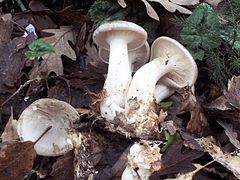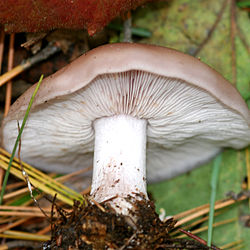- Clitocybe
-
Clitocybe 
Scientific classification Kingdom: Fungi Division: Basidiomycota Class: Agaricomycetes Order: Agaricales Family: Tricholomataceae Genus: Clitocybe
(Fr.) Staude (1857)[1]Type species Clitocybe nebularis
(Batsch) P.Kumm. (1871)Hundreds of species of mushrooms compose the fungus genus Clitocybe. They are characterized by white, off-white, buff, cream, pink, or light-yellow spores, gills running down the stem, and pale white to brown or lilac coloration. They are primarily saprotrophic, decomposing forest ground litter. There are estimated to be around 300 species in the widespread genus.[2]
Clitocybe means sloping head.
A few members of the genus are considered edible; many others are poisonous, containing the toxin muscarine among others. Distinguishing individual species of Clitocybe is generally prohibitively difficult to non-experts, requiring the analysis of microscopic characters. Therefore, with the exception of a few charismatic and readily identified members, Clitocybe mushrooms are rarely collected for consumption.
Recent molecular work has shown the genus to be polyphyletic, with many members seemingly distantly related and other fungi, such as the field blewit and wood blewit, now known as Clitocybe saeva and C. nuda respectively, are more closely related. As C. nebularis is the type species[3], those most distantly related to it would be likely to be reclassified in the future.
In a 2003 paper, Finnish mycologist Harri Harmaja proposed C. geotropa and twelve other Clitocybe species be split off into a new genus Infundibulicybe on the basis of spore properties. He also reclassified C. clavipes in the genus Ampulloclitocybe, that genus name taking precedence over his own proposal Clavicybe.[4]
Contents
Toxicity
The consumption of two species, Clitocybe acromelalga from Japan,[5] and Clitocybe amoenolens from France,[6] has led to several cases of mushroom-induced erythromelalgia which lasted from 8 days to 5 months.[7]
Many small Clitocybe species contain the toxin muscarine, which was originally found in small amounts in the famous fly agaric. However, the small white Clitocybe species contain muscarine in dangerous amounts, and two species in particular, the closely related Clitocybe dealbata and Clitocybe rivolusa, contain muscarine in deadly amounts, and deaths have been recorded for eating those two Clitocybe species.
Selected species
- Clitocybe acromelalga (Japan)
- Clitocybe alexandri
- Clitocybe amoenolens — poisonous bamboo mushroom (France)
- Clitocybe brumalis — Winter Funnel Cap
- Clitocybe candicans
- Clitocybe candida
- Clitocybe cerussata
- Clitocybe clavipes — may be edible but poisonous when consumed in conjunction with alcohol
- Clitocybe dealbata — ivory funnel, sweating mushroom (Europe), poisonous
- Clitocybe ditopus
- Clitocybe dilata
- Clitocybe eccentrica
- Clitocybe entoloma
- Clitocybe eucalyptorum
- Clitocybe flaccida
- Clitocybe fragrans '— fragrant funnel
- Clitocybe geotropa— trooping funnel, monk's head agaric
- Clitocybe glacialis
- Clitocybe glutiniceps
- Clitocybe maxima
- Clitocybe nebularis — clouded agaric - considered edible by some, though causes gastric upset in many people
- Clitocybe nuda — Wood blewit — a common edible distinguished in part by its lilac hue
- Clitocybe odora — Aniseed toadstool; grows near birch trees, but can be easily mistaken for poisonous ones mainly because of its appearance
- Clitocybe parasitica
- Clitocybe rivulosa - Fool's Funnel (Europe, North America)
- Clitocybe sclerotoidea
- Clitocybe truncicola
- Clitocybe vibecina
The bioluminescent jack o'lantern mushroom (Omphalotus olearius) was formerly placed in this genus as Clitocybe illudens.
See also
- Mushroom hunting
- Mushroom poisoning
- List of Tricholomataceae genera
External links
References
- ^ Staude F. (1857) (in German). Die Schwämme Mitteldeutschlands, in besondere des Herzogthums. pp. 1–150.
- ^ Kirk PM, Cannon PF, Minter DW, Stalpers JA. (2008). Dictionary of the Fungi (10th ed.). Wallingford, UK: CABI. p. 152. ISBN 9780851998268.
- ^ Redhead, S.A. et al. (2002a). "Phylogeny of agarics: partial systematics solutions for core omphalinoid genera in the Agaricales (euagarics)". Mycotaxon 83: 19–57.[1]
- ^ Harmaja, Harri (2003). "Notes on Clitocybe s. lato (Agaricales)" (PDF). Annales Botanici Fennici 40: 213–18. http://www.sekj.org/PDF/anb40-free/anb40-213.pdf.
- ^ Ichimura, J (1918). "A new poisonous mushroom". Bot Gaz (Tokyo) 65: 10911.
- ^ Saviuc PF, Danel VC, Moreau PA, Guez DR, Claustre AM, Carpentier PH, Mallaret MP, Ducluzeau R (2001). "Erythromelalgia and mushroom poisoning". J. Toxicol Clin Toxicol 39 (4): 403–07. doi:10.1081/CLT-100105162.
- ^ Diaz, James H. (2005). "Syndromic diagnosis and management of confirmed mushroom poisonings". Critical Care Medicine 33 (2): 427–36. doi:10.1097/01.CCM.0000153531.69448.49. PMID 15699849.
Categories:
Wikimedia Foundation. 2010.

